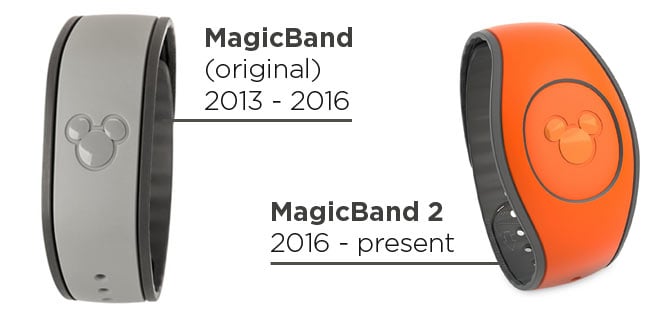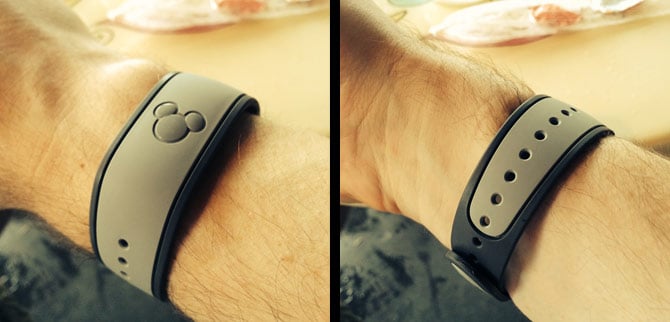In 2013, Disney's MagicBand revolutionized the theme park and resort industry.
Estimated to have cost over $1bn the wristbands formed part of the 'My Disney Experience' project which also tied-in the use of a cutting-edge mobile app to help guests plan and manage their trips.
For Disney, it was simple. If they enhanced the experience, more people would spend more time in their parks, ultimately, spending more money.
Five years on, we look back at how Disney's MagicBand has been used to deepen relationships with customers. And, how an intelligent RFID wristband helps create lasting experiences and drive new revenues.
But, did they get everything right?
Here are 10 things we think other resorts and theme parks can learn from Disney's MagicBand.
Oh, and before we start, just in case you didn't know...
What is a MagicBand?
Disney's MagicBand is a custom wristband that acts as the central nervous system of the MyMagic+ experience. Together, the MagicBand and Disney mobile app provide ways for the Park's integrated systems to offer various enhancements for its guests.
The wearable bracelet is embedded with RFID technology used to electronically store and access ticket information, book Fast Passes, make hotel reservations, process cashless payments, and even open the door to your Disney hotel room.

1. Disney's MagicBand was a branding masterstroke
Apple, Coke, Disney. Like them or loathe them, you cannot deny their brand power.
Disney could have introduced an off-the-shelf product that functioned the same as the MagicBand and would have probably cost a whole lot less. (For the record, we have no idea what Disney's MagicBands cost, but we know enough to know they're probably not cheap).
But that's not the Disney way. They saw the MagicBand as an opportunity to create something unique. Something that guests could completely customize with their favorite colors and even their favorite Disney characters.
Customization is key
On the face of things, the MagicBands look fairly plain. The standard models are available in a simple choice of solid colors. This is no accident. The minimal design instantly created a desire for personalization. Fans who buy annual membership can have their names engraved on the bands for free.

A series of special editions would soon follow, giving park goers the chance to have something others didn't.
Disney was masterfully empowering its fans to create their own affinity with its brand. All driven by what is essentially a piece of plastic.
They thought of everything.
Disney even solved the problem of the wristband fitting different-sized wrists, with each band splitting in a smaller version if required.

Put simply, MagicBands are cool. And, the fact they're tied to your wrist for the duration of your stay, gives you a weird sense of belonging that's actually kind of nice.
2. Create a product that keeps earning
The MagicBand's various customization options allowed Disney to monetize their new venture from day one.
What else did you expect?
Each year they introduce new designs, hundreds of limited editions, and have an enormous range of 'MagicBandits'- little rubber push-in tags that clip around the spare holes in your MagicBand strap.
The vast options and extras hold the interest of the die-hard fans (of which Disney has many millions of) and makes it easy for little jack or sally to find the exact wristband they want mum and dad to buy them.
The Apple model...
Disney regularly rolls out new iterations, keeping the MagicBand desirable for each new generation of park-goers.
In early 2017 they introduced the MagicBand 2, with even more customizable options. The new version of the band, which is still in use, has a center disc called the 'icon' that can be 'easily' removed with one of those tiny screwdrivers.

This part of the MagicBand contains the RFID tag and can be switched between different style straps - while keeping all of the important data in one place.
There's even the option to turn it into a keychain. Perfect for those who insist they're too cool to wear a wristband
3. Revive in-experience purchasing
In the age of the smartphone, sales of printed photo memories at theme parks have declined. But, Disney has managed to rejuvenate sales by adding connecting its PhotoPass service to the MagicBands.
Professional photographers are situated at prime locations throughout the parks and are more than happy to capture those special moments without any commitment to pay. And with a tap of the RFID-enabled MagicBand, visitors will shortly see the images appear within their app.
The photos are heavily water-marked, but the point is that Disney has enabled its park attendees to make the decision about purchasing photos after they've visited the park. There's less pressure on guests to commit to spending and less friction in the experience.
4. Reduce the chance of fraud
One of the most convenient features the bands offer is the ability to store validated park tickets. With a tap of their wrist on one of many RFID Mickey-branded readers at the park and a quick fingerprint check, they are in!

For families, this is a welcome convenience. No holding onto a wedge of paper tickets and scrambling at the gate to figure out who's is who's. For park operators, mixing the security of RFID with biometrics makes it practically impossible to gain invalid entry.
Keeping Disney's bottom line healthy and keeping out unwanted guests.
Could Disney do better?
If Disney could learn anything from the way music festivals use RFID wristbands, it would be to reduce the need for two types of credential to gain access to the park.
Unless residing in one of Disney's on-site hotels, annual pass holders still have to carry a Disney RFID card to validate complimentary parking. What the park could do, is have guests wear their wristbands as they approach the parking lot pay stations, and simply reach out to scan their wristbands for validated parking.
This would be one less thing to carry for families and is a super-convenient way to validate your complimentary parking.

5. Cut the queues
No one likes to waste time queuing, especially at theme parks. And Disney was able to manage this with the addition of fast passes. By introducing this free cut-the-line service, Fastpass+ allows guests to choose up to three-time slots for attractions each day where they'll only have to queue for a short time.
The fast passes are linked to the MagicBand and validated by tapping against one of the Mickey Mouse-themed RFID readers situated at the ride's entrance.
6. Make it a hassle-free experience
From airport pick-up, to resort check-in, and park visits, the MagicBand has drastically changed the way visitors do just about everything. For ultimate convenience, with just one MagicBand, guests can forget their worries of holding multiple tickets and resort room keys. And, if they are staying on-site, they can even use their MagicBand for cashless payments.

But, the pièce de résistance is the fact guests flying into for their vacation can have their luggage collected from the arrival airport and taken to their hotel room.
But how do the Disney hotel staff know which room to leave the luggage in? You guessed it, the MagicBand. Guests opting for the 'Magical Express' luggage transfer service are asked to pack their MagicBands in their checked luggage.
How does this work? The MagicBand actually has two different kinds of embedded RFID antennas. The first is known as HF, of High Frequency. These tags have a shorter reading range, which is perfect for when the bands are scanned against RFID portals around the parks to validate tickets. The other tag is an UHF, or Ultra High Frequency. These tags can have a reading range beyond 10 meters, and are more suited to scanning large objects from a further distance, like people or luggage!
Upon arrival at the hotel, the guest's bags are scanned to validate guests names, reservations, and hotel rooms. Hey, presto! Luggage safely delivered to the guests' hotel room.
Now that's the definition of hassle-free service.
7. Data will help you learn faster than your competitors
Another attractive pull is the data that can be collected through RFID technology. MyMagic+ allows Disney to track guest behavior minute-by-minute. Because Disney can scan MagicBands from a variety of touchpoints, they can gather data from every interaction.
They can track what attractions people have been on, what characters they queue to meet, and where they ate, as well as overall trends. This rich data is priceless to Disney. It gives them the agility and insight to constantly refine their offering.
They can also use this data for advertising purposes. If they know guests like a particular ride or shop, but haven’t been for a few days, and still have their passes activated, they can send offer emails to entice them back into the park.
8. Go cashless
While cashless payments are currently only available for guests staying in a Disney World hotel, research shows that RFID wristbands connected to credit cards will increase spend per head.

Guests become detached from the physical representation of holding their money and handing it over to pay for something. It's convenient and secure for guests. It's profit-making for park operators.
Disney is missing a trick here though. Surely they should roll out cashless payments to all of their park visitors?
9. Create some hype
Anyone who has booked a Disney trip is excited about it. It’s usually something families book up to a year in advance and count down the days. Receiving a package containing MagicBands increases hype around the visit and encourages guests to share where they are going on social media.

10. Connect fans with the rest of your brand ecosystem
The MagicBand is used by guests to navigate around the park. It's used to book restaurants, hotel reservations, check queue times, and book FastPasses.
But what's neat is that Disney's MagicBand keeps guests connected with the rest of the Disney ecosystem. The bands utilize the Disney app, which itself is connected to the Disney website, where visitors are connected to pretty much every part of the Disney empire.
Yes, the wristband is increasing the customer lifetime value to Disney.
Conclusion
5 years ago Disney's MagicBand re-shaped the theme park experience. Delivering convenience on multiple levels, and performing as a marketing and revenue tool for the Disney Corp, this wristband has achieved a lot.
But even Disney didn't get it perfect. Its biggest rival Universal Studios recently took the wristband convenience to another level. The TapuTapu wristband at the newly-opened water park Volcano Bay, allows guests to book time-slots for rides, completely eliminating the need to queue altogether.
Other resorts and park operators may not have the capital Disney has, but they can still learn from the MagicBand.
RFID is one of the key technologies beneath all the awesome branding and functionality the MyMagic+ experience delivers. This is just one example of successful RFID brand activations.
And, RFID technology for resorts and theme parks is more popular than ever, with more system providers helping to drive-down pricing and increase the options available to park owners of all sizes.







